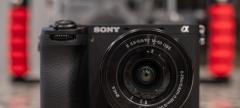The Yucatán Dive Trek: Behind the Scenes
We recently caught up with wildlife videographer William Drumm about a web series he put together with fellow lensman Andy Trace: The Yucatán Dive Trek.
The diving tour took place across (you guessed it) Mexico's famed Riviera Maya; diving reefs and cenotes and snorkeling with some big exciting animals. The adventure was organized by sponsor Yucatán Dive Trek, who did an excellent job showing these two videographers the local diving opportunties.
The video series takes us along for the ride, with beautiful underwater footage mixed with the usual topside culture, food, shenanigans and inside jokes that come so natural on dive trips. We watched all 5 episodes and now can't wait to get back to dive the Yucatan!
- The Editors
UWPG: How did you plan this trip and web series idea?
William Drumm: What’s great about Yucatán Dive Trek is they take all the hassle out of planning the trip. You basally tell them what kinds of diving you want to do (Cozumel, cenotes, bull sharks, sail fish, whale sharks, tech diving, crocodiles, giant tarpon, etc.) and they help you plan it all. The trip we went on was a bit of all the best stuff that was offered during the time of year we went, which was May 2016.
What was your favorite part of the trip?
WD: By far my favorite part of the trip was in Chinchorro, diving with huge American crocodiles. It was the best single ocean adventure I have ever been on. Banco Chinchorro is an offshore atoll reef lying off the southeast coast of Quintana Roo, Mexico, near Belize. Around the diving is amazing diving, with most of the reefs still unchartered and never before dived. On the way out, you dive at some of these little seen reefs, and spearfish for invasive lion fish, used to lure in the crocodiles, and served as dinner for the guests once you arrive. While in Banco Chinchorro you stay in a small fisherman’s hut (shared between XTC dive center and a very friendly local fisherman). Almost right away, the crocodiles began to pop up around the fishing hut. The American Crocodile is a relatively large species, with males reaching a length of 5-6 meters, and females generally measure 3-3.5m in total length. Although the American Crocodile is similar in size to the salt water crocodile (Cocodrylus Porous) and the Nile Crocodile (Cocodrylus Niloticus), it is not as aggressive and does not include human beings as part of its diet, as the other two species do. Nevertheless, being in the water with these dinosaurs is definitely a rush! The entire experience, from the amazing coral reef diving around the atoll, to sleeping in the small fisherman’s hut, to interacting with the crocodiles themselves, was incredible.
Were there any challenges to getting the right shots for the series?
WD: The series was a run and gun operation. I found out that I was going a few days before the trip, and we showed up eager but not knowing what to expect. What followed was 15 day dash up and down the Yucatan, all over Quintana Roo, and ending up in a lagoon near XTC Dive Center with Mexico on one side and Brazil on the other. We had lots more adventures that didn’t make it into the series, including going to Cozumel for quick half day trip, and going to Calakmul Mayan ruins. There were absolutely challenges, mostly involved with the logistics of hitting so many spots in a relatively short amount of time. When you plan your trip, don’t rush things. There is so much to see, but best to only hit a few of the amazing dive sites and activites on each trip.
What camera gear were you using underwater?
WD: I was using my Lumix GH4 and Nauticam GH4 housing, primarily with my 8mm Lumix fisheye. I also used the 12-50mm medium angle - macro zoom lens, and 60mm macro that I rented from Bluewater Photo. My lights were 2x Light & Motion SOLA 2500’s, and 2x I-Torch Venom 50’s, also from Bluewater Photo. I ended up shooting almost all wide angle, (crocodiles, cenotes, whale sharks), but loved the 12-50mm for its versatility. I also liked the I-Torch Venom 50’s. They were nice and bright, however they seemed a bit cooler temperature than I am used to and I had an unattractive oval where the two lights met, at least while diving cenotes.
Andy Trace, who filmed all the shots of me and some of the wildlife and other dive footage, was using his Sony A7RII, with a cheap ($260) Meikon plastic housing. For the price, we were both surprised that the Meikon worked as well as it did, although it probably works fine until it doesn’t and it floods.
Watch The Yucatán Dive Trek
Episode 1: Swimming with Giant Crocodiles
Episode 2: The Yucatán Culture Vulture
Episode 3: Cenote Tajma-Ha and Casa
Episode 4: Cenote Car Wash and The Pit
Episode 5: Insane Whale Shark Aggregation
View more of William Drumm's work at WilliamDrumm.com and follow him on YouTube, Facebook, Instagram, and Twitter.
RECOMMENDED ARTICLES
SUPPORT THE UNDERWATER PHOTOGRAPHY GUIDE:
The Best Service & Prices on u/w Photo Gear
 Visit Bluewater Photo & Video for all your underwater photography and video gear. Click, or call the team at (310) 633-5052 for expert advice!
Visit Bluewater Photo & Video for all your underwater photography and video gear. Click, or call the team at (310) 633-5052 for expert advice!
The Best Pricing, Service & Expert Advice to Book your Dive Trips
 Bluewater Travel is your full-service scuba travel agency. Let our expert advisers plan and book your next dive vacation. Run by divers, for divers.
Bluewater Travel is your full-service scuba travel agency. Let our expert advisers plan and book your next dive vacation. Run by divers, for divers.






























